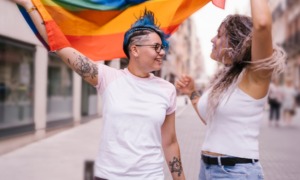 Lesbian, gay, bisexual, transgender and questioning (LGBTQ) youth are in foster care for many of the same reasons that non-LGBTQ youth are in care: abuse or neglect by their parents or other family members.
Lesbian, gay, bisexual, transgender and questioning (LGBTQ) youth are in foster care for many of the same reasons that non-LGBTQ youth are in care: abuse or neglect by their parents or other family members.
For many LGBTQ youth, however, there is an added layer of trauma that comes with being rejected or mistreated by their families because of their sexual orientation or gender identity. Many LGBTQ youth report being kicked out of their homes after coming out as LGBTQ, or facing physical or verbal abuse based on their identity and choosing to run away in order to stay safe.
In addition to the many teens entering care with their LGBTQ identity already shaped, an estimated 5 to 10 percent of children in foster care will identify as LGBTQ in adolescence or early adulthood. We have heard repeatedly from LGBTQ youth that they do not feel safe coming out while in the system, either for fear that a foster or adoptive family won’t want them, or because they have seen and heard anti-LGBT bias by their peers, social workers and other agency staff.
Another significant challenge to permanency for LGBTQ youth is the lack of safe, affirming homes. With the exception of California, there are no state mandates or laws that require LGBTQ preservice training for foster parents, nor are there routine assessments of the knowledge, attitudes and willingness of foster parents to support and affirm a child who discloses an LGBTQ identity. Far too many youth are rejected by their foster parents upon coming out, mistreated by staff and more vulnerable to unnecessary placements in group homes.
The hostility within systems of care forces many LGBTQ youth to make the difficult decision to run away, to engage in “survival sex” and to make their way on the streets rather than subject themselves repeatedly to abuse and rejection within the system charged with caring for their safety and well-being.
While we do not yet have federal policy that prohibits discrimination on the basis of sexual orientation and gender identity, we do have an established set of best practices and model policies that can guide child welfare professionals in optimizing the potential for safety, permanency and well-being among LGBTQ youth in foster care.
The time is now for child welfare leaders to acknowledge that we have neglected to fully and responsibly address the unique challenges faced by LGBTQ youth in care, and to put in place an action plan for assessing, monitoring and improving outcomes for this segment of our foster-care population, including:
- Implement LGBTQ nondiscrimination policies protecting youth and prospective foster and adoptive parents
- Pass federal legislation prohibiting sexual orientation and gender identity discrimination by foster agencies receiving taxpayer funding
- Require youth service providers to receive LGBTQ cultural competency training
- Implement state and local foster children’s bills of rights
- Include sexual orientation and gender identity in agency data collection systems.
For the first time in history, a presidential proclamation on foster youth explicitly addressed sexual orientation and gender identity. President Obama said in his 2015 National Foster Care Month Proclamation “all young people, regardless of what they look like, which religion they follow, who they love, or the gender they identify with, deserve the chance to dream and grow in a loving, permanent home.”
Let’s honor his vision for safety, permanency and well-being for all children and youth, including those who are lesbian, gay, bisexual, transgender and questioning, by stepping up our efforts on inclusion and equality within our foster-care system.
Ellen Kahn is director of the Children, Youth and Families Program for the Human Rights Campaign, the largest U.S. civil rights organization working to achieve lesbian, gay, bisexual and transgender equality.






























